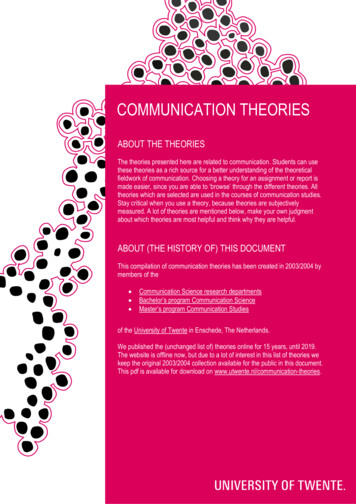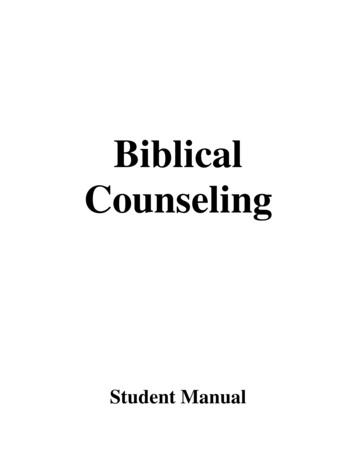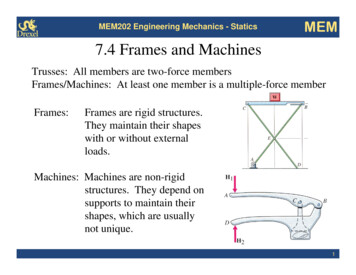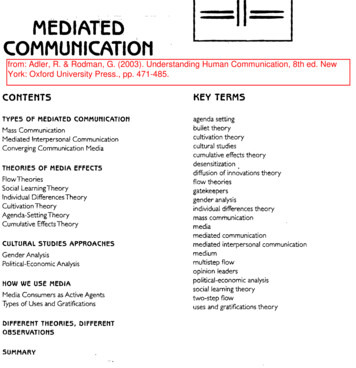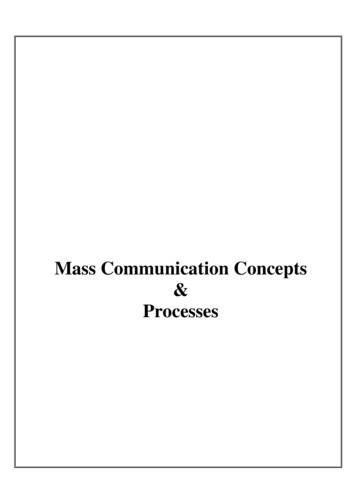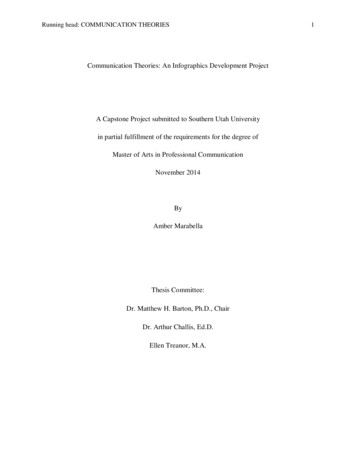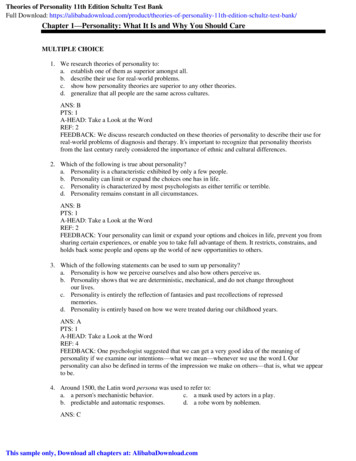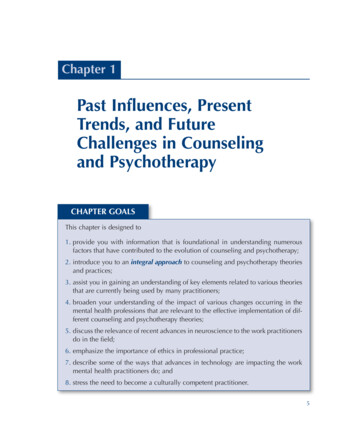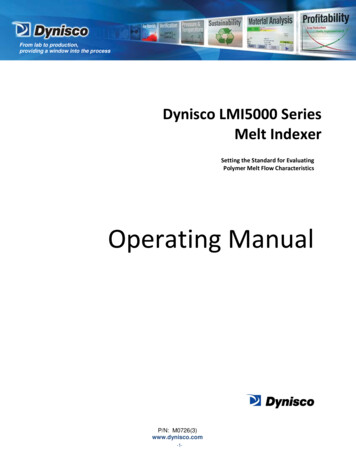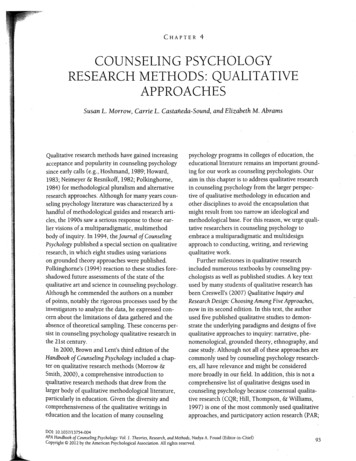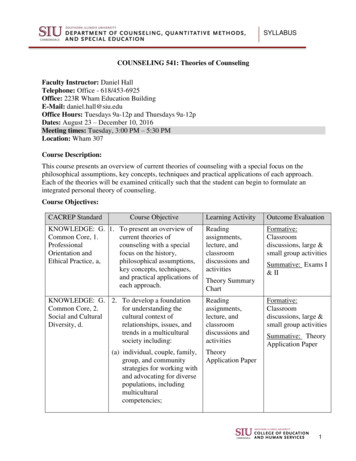
Transcription
SYLLABUSCOUNSELING 541: Theories of CounselingFaculty Instructor: Daniel HallTelephone: Office - 618/453-6925Office: 223R Wham Education BuildingE-Mail: daniel.hall@siu.eduOffice Hours: Tuesdays 9a-12p and Thursdays 9a-12pDates: August 23 – December 10, 2016Meeting times: Tuesday, 3:00 PM – 5:30 PMLocation: Wham 307Course Description:This course presents an overview of current theories of counseling with a special focus on thephilosophical assumptions, key concepts, techniques and practical applications of each approach.Each of the theories will be examined critically such that the student can begin to formulate anintegrated personal theory of counseling.Course Objectives:CACREP StandardCourse ObjectiveLearning ActivityOutcome EvaluationKNOWLEDGE: G. 1. To present an overview ofCommon Core, 1.current theories ofProfessionalcounseling with a specialOrientation andfocus on the history,Ethical Practice, a,philosophical assumptions,key concepts, techniques,and practical applications ofeach approach.Readingassignments,lecture, andclassroomdiscussions andactivitiesFormative:Classroomdiscussions, large &small group activitiesKNOWLEDGE: G. 2. To develop a foundationCommon Core, 2.for understanding theSocial and Culturalcultural context ofDiversity, d.relationships, issues, andtrends in a multiculturalsociety including:Readingassignments,lecture, andclassroomdiscussions andactivities(a) individual, couple, family,group, and communitystrategies for working withand advocating for diversepopulations, includingmulticulturalcompetencies;Summative: Exams I& IITheory SummaryChartFormative:Classroomdiscussions, large &small group activitiesSummative: TheoryApplication PaperTheoryApplication Paper1
SYLLABUSCOUN 541-3KNOWLEDGE: G. 2. To develop a foundationCommon Core, 2.for understanding theSocial and Culturalcultural context ofDiversity, e.relationships, issues, andtrends in a multiculturalsociety including:Readingassignments,lecture, andclassroomdiscussions andactivities(b) counselors’ roles indeveloping cultural selfawareness, promotingcultural social justice,advocacy and conflictresolution, and otherculturally supportedbehaviors that promoteoptimal wellness andgrowth of the human spirit,mind, or body;KNOWLEDGE: G. 2. To develop a foundationCommon Core, 2.for understanding theSocial and Culturalcultural context ofDiversity, f.relationships, issues, andtrends in a multiculturalsociety including:TheoryApplication Paper(c) counselors’ roles ineliminating biases,prejudices, and processesof intentional andunintentional oppressionand discrimination.KNOWLEDGE: G. 3. To develop a foundationCommon Core, 5.for understanding theHelpingcounseling process in aRelationships, a.multicultural societyincluding:(a) an orientation to wellnessand prevention as desiredcounselinggoals;PersonalCounseling TheoryPaperFormative:Classroomdiscussions, large &small group activitiesSummative:Theory ApplicationPaperPersonal CounselingTheory PaperWeekly JournalsReadingassignments,lecture, andclassroomdiscussions andactivitiesTheoryApplication PaperPersonalCounseling TheoryPaperReadingassignments,lecture, andclassroomdiscussions andactivities;PersonalCounseling TheoryPaperFormative:Classroomdiscussions, large &small group activitiesSummative:Theory ApplicationPaperPersonal CounselingTheory PaperFormative:Classroomdiscussions, large &small groupactivities;Summative: Exams I& IIPersonal CounselingTheory Paperan orientation to wellness2
SYLLABUSCOUN 541-3and prevention as desiredcounseling goals;KNOWLEDGE: G. 3. To develop a foundationCommon Core, 5.for understanding theHelpingcounseling process in aRelationships, b.multicultural societyincluding:(b) counselor characteristicsand behaviors thatinfluence helpingprocesses;KNOWLEDGE: G. 3. To develop a foundationCommon Core, 5.for understanding theHelpingcounseling process in aRelationships, c.multicultural societyincluding:(c) counseling theories thatprovide the student withmodels to conceptualizeclient presentation and thathelp the student selectappropriate counselinginterventions. Students willbe exposed to models ofcounseling that areconsistent with currentprofessional research andpractice in the field so theybegin to develop a personalmodel of counseling;KNOWLEDGE:G. Common Core,5. HelpingRelationships, d.3. To develop a foundationfor understanding thecounseling process in amulticultural societyincluding:(d) counseling theories thatprovide the student withmodels to conceptualizeReadingassignments,lecture, andclassroomdiscussions andactivitiesPersonalCounseling TheoryPaperReadingassignments,lecture, andclassroomdiscussions andactivitiesPersonalCounseling TheoryPaperFormative:Classroomdiscussions, large &small group activitiesSummative:Personal CounselingTheory PaperFormative:Classroomdiscussions, large &small group activitiesSummative:Personal CounselingTheory PaperTheory SummaryChartWeekly JournalsAssigned readingsin text andsupplementalsources; studentswrite a TheoryApplication Paperand a PersonalTheory PaperFormative:Instructor’sobservation ofclassroom discussion,bi weekly journals.Summative: MidTerm and FinalExams; TheoryApplication Paper,3
SYLLABUSCOUN 541-3client presentation and thathelp the student selectappropriate counselinginterventions. Studentswill be exposed to modelsof counseling that areconsistent with currentprofessional research andpractice in the field so theybegin to develop apersonal model ofcounselingKNOWLEDGE: G. 3. To develop a foundationCommon Core, 5.for understanding theHelpingcounseling process in aRelationships, e.multicultural societyincluding:(d) systems perspectives thatprovide an understandingof family and othersystems theories and majormodels of family andrelated interventions;Personal TheoryPaper.Readingassignments,lecture, andclassroomdiscussions andactivitiesTheoryApplication PaperFormative:Classroomdiscussions, large &small group activitiesSummative: ExamsI & II; TheoryApplication PaperTheory SummaryChartWeekly JournalsCLINICALMENTALHEALTH:Foundations, A.Knowledge, 53. To develop a foundationfor understanding thecounseling process in amulticultural societyincluding:(e) models and theories relatedto clinical mental healthcounselingReadingassignments,lecture, andclassroomdiscussions andactivitiesTheory SummaryChartFormative:Classroomdiscussions, large &small group activitiesSummative: Exams I& II; TheoryApplication PaperTheoryApplication PaperWeekly JournalsSCHOOLCOUNSELING:Counseling,Prevention, andIntervention, C.Knowledge, 1.3. To develop a foundationfor understanding thecounseling process in amulticultural societyincluding:Readingassignments,lecture, andclassroomdiscussions andactivities;Formative:Classroomdiscussions, large &small groupactivities; TheorySummary Chart4
SYLLABUSCOUN 541-3(f) theories and processes ofeffective counseling andwellness programs forindividual and groups ofstudents in a school setting.Theory SummaryChartTheoryApplication PaperSummative: Exams I& II; TheoryApplication PaperMethod of Instruction:The course will use background reading, lecture, interactive discussion, group work, presentations,and thematic assignments to help students acquire declarative knowledge related to the theoreticaldevelopment and models of practice for professional counseling. Students will be assessed byformative and summative means across the spectrum of Bloom’s taxonomy to address educationalobjectives.Course PrerequisitesCOUN 493 or concurrent enrollment in COUN 493Required Text, Reference, and Readings:Rogers, C. R. (1957). The necessary and sufficient conditions of therapeutic personality change.Journal of Consulting Psychology, 21, 95-103 / (1992). Journal of Consulting and ClinicalPsychology, 60, 827-832.Seligman, L. & Reichenberg, L. (2013). Theories of counseling and psychotherapy: Systems,strategies, and skills (4th ed.). Upper Saddle River, NJ: Pearson.Spruill, D. A., & Benshoff, J. M. (2000). Helping Beginning Counselors Develop a PersonalTheory of Counseling. Counselor Education and Supervision, 40(1), 70-80.Recommended:American Psychological Association. (2009). Publication manual of the American PsychologicalAssociation (6th ed.). Washington, DC: APA. http://www.apastyle.org/Halbur, D. & Halbur, K. (2011). Developing your theoretical orientation in counseling andpsychotherapy (2nd ed.). Upper Saddle River, NJ: Pearson.Professional LinksAmerican Counseling Association (ACA) http://www.counseling.org---ACA Ethics P/Home/CT2.aspxCouncil for Accreditation of Counseling & Related Educational Programs (CARCEP)http://www.cacrep.orgIllinois Department of Financial & Professional Regulation. Professional elor.asp5
SYLLABUSCOUN 541-3Alexander Street Press Videos http://vasc.alexanderstreet.comStudent Performance Evaluation Criteria:1.Grade Requirement - Any student enrolled in the Counselor Education program must earn anA or B in COUN 541 to continue progress toward graduation in the program and to enroll inpracticum courses. According to the Counselor Education Master’s Handbook, students whoreceive lower than a “B” in COUN 541 cannot remain in the program unless they petition thefaculty for permission to retake the course, and the faculty consents.2.Attendance & Participation Policy - Attendance is necessary and expected. Investing in yourlearning minimally requires that you comprehend the course syllabus, attend class on time, andbe prepared for class. Students are expected to read assigned material before class and comeprepared to discuss the topic. Effective class participation includes: respectful and nondominating involvement in class discussions and group activities, leading classroombrainstorms, and showing initiative and investment in classroom activities. Cell phones,unless the instructor grants special permission, should be off. Poor attendance andparticipation indicate a person is not yet ready to assume the responsibilities of a professionalcounselor.3.Written Assignments - All written assignments must conform to the guidelines provided in theAPA Style Manual. Some of those criteria include double space, 1-inch margins, 12 pointTimes New Roman typeface, cover page, running head, and pagination. Each paper will beevaluated using the evaluation form found in Appendix A. All written assignments should beturned in electronically via D2L. Paper copies and assignments sent via email will not beaccepted.4.Mastery Grading - The instructor(s) will be using a modified mastery approach for assigningcourse grades. To receive a course grade, all criteria for that grade must be met. High scoresin one task cannot be used to supplement low scores in another. Assessments of papers aresubjective, that is, they are based on the judgments of well-qualified instructor(s) using thescoring rubric in Appendix B.5.Late Assignments - Late assignments are subject to grade penalties. Ten (10) points will bededucted for each calendar day the assignment is late. Assignments not submitted to D2L bythe beginning of class (i.e., 3:00 pm) are considered one day late. (NOTE: D2L places a timestamp on all submitted assignments)6.Incomplete Grade - A written request for an Incomplete grade (INC) along with a time-linecommitment to finish seminar requirements must be submitted to the instructor 7 days beforethe last day the class is scheduled to meet, that is, no later than 3:00 pm, Tuesday, November26th. An INC will be considered only if the student is achieving passing work and only forextenuating life circumstances, not procrastination, computer failure, or inclement weather.Medical circumstances will be considered only if accompanied by a supporting letter from aphysician or a licensed medical or mental health provider. The instructor will consider the INCrequest, and provide a written response within 48 hours of the request. A course incompletemust be made-up by the end of the following semester. If it is not, a grade will be assigned6
SYLLABUSCOUN 541-3based on the work completed. See Appendix F (Provost’s Syllabus Attachment) for universitypolicy regarding INC grades.Assignments:1.Weekly Journal – Journal submissions begin following Session 2 and continuing through theremainder of the semester and are due by 11:59 PM on Sundays (except as noted below).Journals should specifically address theoretical concepts learned that week and your owncritique of the theoretical models and concepts. Please indicate your personal reflection andhow the concepts may apply to your practice as future counselors. The Individual Exercises atthe end of each chapter in the Seligman text provide prompts/suggestions for journal writing.Journals are expected to be 1-2 pages. The instructor may provide additional structure orprompts throughout the semester.2.Exams - Two exams will provide a measure of the acquisition of declarative knowledge of thevarious counseling and/or therapy theories. Exam I will cover Seligman & Reichenberg:Chapters 1-4, 7-14 and any assigned readings during the previous weeks. Exam II will coverSeligman & Reichenberg: Chapters 15-23 and any assigned readings during the previousweeks. The exams will use a multiple-choice format.3.Class Presentation - At the beginning of the semester you will select a theory to present onduring class. You will be expected to bring one article on any topic relating to your theory. Forexample, if you have selected cognitive behavioral therapy (CBT) you can present on an articlediscussing CBT interventions being used among elderly populations. You will also be expectedto share with the class your thoughts and reactions to the article and how it can be related to theassigned reading. Please be prepared to provide me with an electronic copy of the article twoweeks before your scheduled presentation. Presentations are expected to be 10-15 minutes inlength.I understand choosing a theory might be difficult, depending on your prior familiarity andknowledge with counseling theories. Your possible current lack of understanding is what willmake this a much more rewarding and rich experience. There is no “right” or “wrong” answersto this assignment. I ask that you take it seriously, choose a topic that interests you, and mostimportantly allow yourself to be open to learning. Have fun with this assignment!4.Personal Counseling Model Paper Part I - One of the primary purposes of this course is toencourage you to do the critical thinking necessary to begin development of your own originalcounseling model – a model consistent with the person you are, a model that aligns with yourphilosophy of life, a model that blends your creation with established scholarly models. Withthis in mind, you will write two papers that articulate your emerging conceptual model forhelping others.For this paper, choose one theory of psychotherapy and demonstrate how this theory fits yourown personal theoretical orientation to counseling so far. Draw on class readings, classdiscussions, personal reflections and/or journals and one primary source for the theory youdiscuss. The Seligman text or any other textbook is not a primary source! Include the keyconcepts of your approach, your view of your role as a therapist, therapeutic goals, and centraltechniques and methods. Explain why this approach fits for you as a counselor. For moreinformation, please see Appendix C.7
SYLLABUSCOUN 541-35.Personal Counseling Model Paper Part II - Incorporating and using Part I as a starting point,further articulate your own personal theoretical orientation to counseling, particularly as itrelates to all of the theories you have studied. Draw on the class readings, class discussions,and personal reflections. Use of one primary source is required for this paper (you may use theone from Part I). A minimum of 7 sources are required for this paper. Again, include the keyconcepts of your approach, your view of your role as a therapist, therapeutic goals, and centraltechniques and methods. Explain why this approach fits for you as a counselor, and how yourorientation has developed from the beginning to the end of the semester.In the second part of this paper, you will use first part of this paper to address the case study ofRuth, which will be provided to you via D2L. Do not just summarize the client, but instead,show how you will apply your own theoretical integration. For more information, please seeAppendix D.6.Theory Summary Chart - In Appendix E, you will find a template for you to record the majorpoints related to the theories covered in class. The purposes of this chart is to (a) guide yourunderstanding, reading, and discussion of these theories, (b) create standards for comparison ofthe theories, (c) develop a study guide for your future use when studying for class,certification, and licensure examinations, and (d) receive additional exam points. In order toreceive extra credit, ALL theories covered in class and listed on the template for the exam mustbe completed – no partial credit will be given. The charts are due (via D2L) for evaluation onthe same dates as the exams. Satisfactory completion of the chart will result in an additional10 points for the same date exam. Table 4.1 in Halbur & Halbur, 2011 provides an example ofsuch a table; however, your table must be in your own words. I will consider direct copying ofthe Halbur and Halbur as plagiarism.Tentative Course Schedule (August, 2016):Week DateTopicReadings & Assignments8
SYLLABUSCOUN 541-3108/23Course OverviewTheories & Counseling ApproachesTherapeutic AllianceDiversity & MulticulturalismEffective Treatment & BackgroundFocusedFreudian & Adlerian/IndividualPsychology ModelsEmotion-Focused & RogerianModelsRead: course syllabus (D2L).208/30309/06409/13S&R, Chapters 8 & 9Weekly Journal (D2L)S&R, Chapters 10 & 11Weekly Journal (D2L)S&R, Chapters 12, 13 &14Weekly Journal (D2L)10/04Rogerian & Existential TherapeuticModelsGestalt Therapy &Emotion/Sensation ModelsThought-Focused Systems, RationalEmotive Behavior Therapy, &Cognitive TherapyReview & Application Activities509/20609/277810/11FALL BREAK910/18EXAM 11010/251111/01Action-Focused Treatment &Behavior/Cognitive-Behavior TherapyReality Therapy1211/08Family Systems Approaches1311/15Family Systems Approaches1411/22Integrative Therapies1511/29Treatment Systems1612/06EXAM IIS&R, Chapters 1, 2, & 3Weekly Journal (D2L)S&R, Chapters 4, 7 & 8Weekly Journal (D2L)Review Chapters 1-4; 7-14; readingsWeekly Journal (D2L)NO CLASSEXAM I (Chapters 1-4; 7-14; readings)Extra credit Theory Summary Charts are due(D2L)NO Weekly JournalS&R, Chapters 15 & 16Weekly Journal (D2L)S&R, Chapters 17NO Weekly JournalPersonal Counseling Model Paper Part IDue (D2L)S&R, Chapters 18 & Assigned ReadingsWeekly Journal (D2L)S&R, Chapter 18 & Assigned ReadingsWeekly Journal (D2L)S&R, Chapters 19Weekly Journal (D2L)S&R, Chapter 20Weekly Journal (D2L) (Final Journal)EXAM II (Chapters 15-23; readings)Extra credit Theory Summary Charts are due(D2L)9
SYLLABUSCOUN 541-31712/13Final WeekCourse Wrap-upNO Weekly JournalPersonal Counseling Model Paper Part IIDue (D2L)NO Weekly JournalAPPENDIX AProtocol for Evaluating Written Work10
SYLLABUSCOUN 541-3CriteriaAPA Style and FormatPoints048121620(e.g., margins, headings, title page, font size & style, references, running head, citations, etc)comments:Use of the English Language0246810246810(e.g., grammar, spelling, sentence structure, punctuation, etc.)comments:Organization and Clarity0(e.g., visual & content organization, transitional sentences, clarity of theme, attention to providedoutline)comments:Content0 ------------ [] ---------- 60(must be written consistent with provided outline and instructions)comments:Deduction for late submission ( day/s x 10)Total PointsGeneral Comments11
SYLLABUSCOUN 541-3APPENDIX BMastery Grading ProtocolAssessmentABCDAttendance &ParticipationNo unexcusedabsences; activeparticipation ateach sessionNo more thanone unexcusedabsence; activeparticipationEither attendanceor participation isinconsistentBoth attendance& participationare inconsistentWeekly JournalsEach entry issubmitted bydeadlineEach entry issubmitted; onemay be up to 24hrs lateOne entrymissing; no morethan one late.More than oneentry lateand/missingClass PresentationArticlesubmitted 2weeks prior forapproval;presentationdone onscheduled dayArticle submittedat least 1 weekprior forapproval;presentation doneon scheduled dayArticle notsubmitted at least1 week forapproval orpresentation notdone onscheduled dayArticle notsubmitted forapproval andpresentation notdoneCombined 2exams86 – 100 points78 – 85 points70 – 77 points 70 pointsPers Coun Part I86 – 100 points78 – 85 points70 – 77 points 70 pointsPers Coun Part II90 – 100 points80 – 89 points70 – 79 points 70 pointsTheory Sum Chart10 points for acomplete chart10 points for acomplete chart10 points for acomplete chart10 points for acomplete chart12
SYLLABUSCOUN 541-3APPENDIX CPersonal Counseling Model Paper Part I (6-9 pages)One of the primary purposes of this course is to encourage you to critically think about developingyour own counseling style. This style will be consistent with your own values, personality, andphilosophy of life. There are no “right” or “wrong” theories. Your theory must, however, referencein some way the preceding scholarship in counseling theory development, that is, this is to be ascholarly paper not free association ramble.With this in mind, write a paper that articulates your conceptual model of helping others from theperspective of your current understanding of counseling. Throughout your paper, you must compareand contrast your views with those expressed in the text and in the additional source material youuse. You are not expected to choose an existing theory, but rather to reflect on your ownperspectives and beliefs, and how those will inform your choice of conceptual lens.You are expected to use a minimum of four outside resources (other than the required andrecommend texts) including scholarly journal articles and/or books. Any evidenced-based researchused must be from 1996 or after. (Note: the date limit does not apply to theoretical writings.) Thepaper is to be a maximum of 9 pages of text (not including title page or references). The paper shouldbe written in APA format. An abstract is not needed; however, please include a title page and aproperly written reference section.Please use the following outline and formal for your paper. Your grade will depend on addressingeach of the points on the outline. You should use the outline as your paper’s formal headings.Consider this to be a combination of a reflection paper and a research paper. As per current APAstyle, please use first-person language when appropriate (rather than “this writer believes ”). Thepaper should be written in professional, academic writing style, consistent with the writingguidelines in 6th edition of APA Style Manual.I.IntroductionA.Autobiographical connection between you and your future as a counselorB.Transition from autobiography to your key conceptsII.Key ConceptsA.B.C.D.III.View of human nature (including):1. View of human potential2. Issue of determinism3. Influence of the environment upon behaviorAssumptions about personality development that are important to your key concepts.Description of your view of change (e.g. What do you think helps to change behavior,thoughts, emotions, and how can you help to facilitate change?)How have your culture and life experiences influenced your answers to A-C above?What do you envision the therapeutic process being like?A.How would you establish a therapeutic relationship?B.How would you establish goals and a treatment plan?C.Explain the counselor’s role and functions.D.How would your clients experience therapy?13
SYLLABUSCOUN 541-3V.Describe how your theory is appropriate/relevant in your anticipated work setting.VI.How would you determine if your approach is working?VII.How effective would your approach be in working with a variety of clients from variouscultures and contexts?14
SYLLABUSCOUN 541-3APPENDIX DPersonal Counseling Model Paper Part II (9-12 pages)This paper will require two main parts. In the first part, you will summarize and further articulateyour own personal theoretical orientation to counseling, particularly as it relates to all of the theoriesyou have studied. Again, include the key concepts of your approach, your view of your role as atherapist, therapeutic goals, and central techniques and methods. If there are changes from the firstpaper, talk about your development. What changed for you? Explain why this approach fits for youas a counselor, and how your orientation has developed from the beginning to the end of thesemester.Secondly, you will conceptualize a client through your chosen theory. You will be provided with acase study via D2L. Similar to part I, your theory must reference preceding scholarship in counselingtheory. Therefore, the goal of this assignment is a thorough understanding of the referenced theoryor theories.You should use a minimum of 8 sources outside of your course text. At least one source must be anoriginal/primary source from the theory’s founder (e.g., Freud, Adler, Rogers, Beck, Satir). AnEnglish translation of an original written in another language is, of course, acceptable. The paper isto be a maximum of 12 pages of text (not including title page or references). The paper should bewritten in APA format (no abstract needed).A suggested outline with suggested page limits is below. IntroductionKey Conceptso View of human potentialo Issue of determinismo Influence of the environment upon behavioro Assumptions about personality development that are important to your key concepts.o Description of your view of change (e.g. What do you think helps to change behavior,thoughts, emotions, and how can you help to facilitate change?)Your role as therapisto How will you establish rapport?o How will your clients experience therapy?Therapeutic GoalsCentral Techniques and Methodso How will you determine change?How does this approach fit for you as a counselor?How has your orientation developed from the beginning to the end of the semester?Brief introduction of client (1 page). This section should include an overview of thedemographics and presenting concern of the client, and any additional information likeenvironmental context, family, medical issues, or strengths that may be important to mention.Indicate the theory that you will be using to conceptualize your client and a rationale forusing this theory with the client, including individual, contextual, and cultural strengths andother considerations. Provide a brief overview of the theory – main concepts, purpose andgoals of counseling from theoretical viewpoint, and role of the counselor (2-3 pages). Your15
SYLLABUSCOUN 541-3 theory chart will be especially helpful in this section. This section is simply an introductionof the theory – you will go into more detail throughout the paper as you apply the theory tothe client.Conceptualize the client using your selected theory (3-4 pages).o How the client is viewed based on the theory’s view of mental health?o What things you would assess for, based on the theory’s view of assessment?o What would be the short/long term wellness goals with the client, based on the theory?o Treatment/wellness plan for the clientEstimated number of sessions neededSpecific techniques/interventions you will use – including an explanation of the purpose(e.g., why would these be beneficial for the client) and how these will work within yourcurrent conceptualizationAnything else you feel is relevant to your treatment plan (e.g., referrals for supplementalservices, culturally supported advocacy and behavior support that promotes wellness andmind/body/spiritual growth, etc.).Personal reflection on theory (1 page)o How well does this theory apply to your client (e.g., strengths, limitations, wellnessgoals)?o Brief discussion of your thoughts regarding this theory (e.g., is this a theory that you feelfits you? Is this a theory that you will choose to work from with future clients? Why? Arethere other theories that better fit you?)o How does this theory provide a foundation for counselors’ roles in eliminating biases,prejudices, and processes of intentional and unintentional oppression and discrimination?The goal of this assignment is a thorough understanding of the theory. The paper should bepresented in a manner that is professional, and well written (grammar and punctuation will bepart of the grade and should be appropriate for whatever format the paper is written in).Proper APA style citations need to appear throughout the paper.The Paper should include a title page and reference sections.16
SYLLABUSCOUN 541-3APPENDIX EEXAM I THEORY SUMMARY CHARTTheoryMajorTheoristsTheoreticalConcepts /BasicAssumptionsRole ofCounselor/TherapistTreatment Multicultural ClienteleRelevance onalEmotiveBehavioralCognitiveTherapy17
SYLLABUSCOUN 541-3EXAM II THEORY SUMMARY CHARTTheoryMajorTheoreticalTheorist Concepts /sBasicAssumptionsRole ofCounselor/TherapistTreatme Commonnt Goals al ClienteleRelevance Background FocusedFamilyTherapiesEmotionally FocusedFamilyTherapiesPostmodern FamilyTherapiesIntegrativeTherapies18
SYLLABUSCOUN 541-3APPENDIX FSouthern Illinois University Carbondale Campus and Course PoliciesAs adult students it is your responsibility to understand the campus, college, and program policiesrelated to instruction, grading, and granting degrees. These policies are stored and readily av
Counseling Theory Paper Weekly Journals Formative: Classroom discussions, large & small group activities Summative: Theory Application Paper Personal Counseling Theory Paper KNOWLEDGE: G. Common Core, 2. Social and Cultural Diversity, f. 2. To develop a foundation for underst
